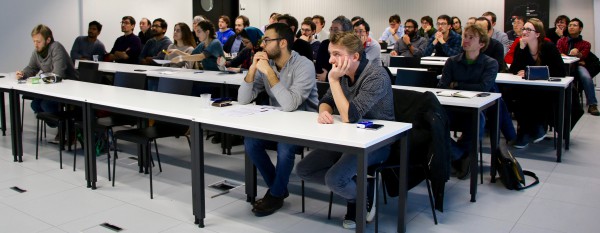MARVEL Junior Seminar — April 2017
The MARVEL Junior Seminars aim to intensify interactions between the MARVEL Junior scientists belonging to different research groups located at EPFL. The EPFL community interested in MARVEL research topics is very welcome to attend. We believe that these events will be central for establishing a vibrant community.
Each seminar consists of two presentations of 25 minutes each, allowing to present on a scientific question in depth, each presentation being followed by 10 minutes for discussion. The discussion is facilitated and timed by the chairperson of the day whose mission is to ensure active lively interactions between the audience and the speakers.
Pizza is served as of 11:45 in the MED hall (floor 0), and after the seminar at 13:30 you are cordially invited for coffee and dessert to continue discussion with the speakers.

MARVEL Junior Seminar Organizing Committee — Ariadni Boziki, Francesco Ambrosio, Fernando Gargiulo, Sandip De, Davide Tiana, Michele Pizzochero, Quang Van Nguyen and Nathalie Jongen
Check the list of the next MARVEL Junior Seminars in 2017 here.
Abstract — Material realization of Kitaev model on honeycomb lattice - Vamshi Mohan Katukuri
Kitaev model on a honeycomb lattice[1] is a rare example of an exactly solvable interacting quantum model in two dimensions. It describes interacting spins on a honeycomb lattice and is a representative of a whole class of quantum spin liquids with Majorana fermions, much relevant in topological quantum computation[2, 3]. Search of materials for physical realisation of Kitaev model has been triggered with the proposal of spin-orbit coupled insulating ground state and strong anisotropic magnetic interactions in iridium oxides[4, 5].
In this talk, I will present an overview of the physics of materials proposed to host Kitaev type of interactions and discuss how anisotropic couplings can be extracted from many- body wave function based ab initio calculations. After a brief introduction to the model and how it can be realized in materials, I will present the results of our ab initio estimates of Kitaev couplings in Na2IrO3, Li2IrO3 and RuCl3. Towards the end, I will highlight our efforts in high-throughput search for materials with Kitaev type of interactions.
References
1. Kitaev, A., Anyons in an exactly solved model and beyond. Ann. Phys., 2006. 321(1): p. 2-111.
2. Kitaev, A. and C. Laumann, Topological phases and quantum computation. arXiv:0904.2771. 2009.
3. Roy, A. and D.P. DiVincenzo, Topological Quantum Computing. arXiv:1701.05052. 2017.
4. Jackeli, G. and G. Khaliullin, Mott Insulators in the Strong Spin-Orbit Coupling Limit: From Heisenberg to a Quantum Compass and Kitaev Models. Phys. Rev. Lett., 2009. 102(1): p. 017205-017205.
5. Kim, B.J., et al., Phase-Sensitive Observation of a Spin-Orbital Mott State in Sr2IrO4. Science, 2009. 323(5919): p. 1329-1329.
Abstract — Quantum properties prediction from optimization point of view - Quang Van Nguyen
We compare improvements in prediction (with respect to root-mean-squared root error (RMSE), mean absolute error (MAE) and max absolute error (maxAE) of different regression models and of multiple kernel regression models using ball constraint and simplex constraint.
Low-volume newsletters, targeted to the scientific and industrial communities.
Subscribe to our newsletter